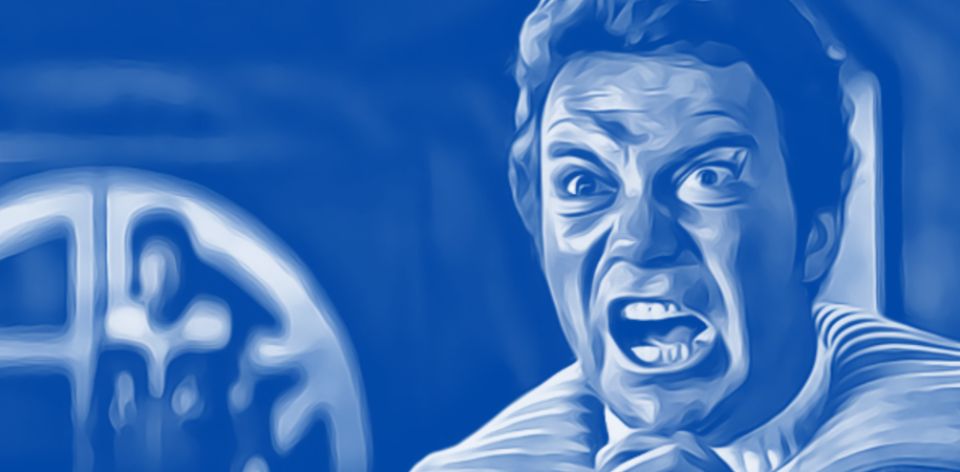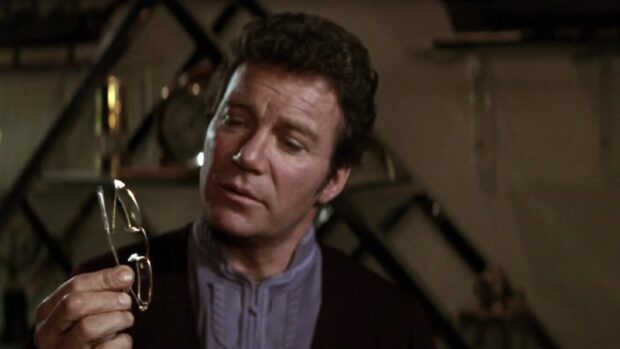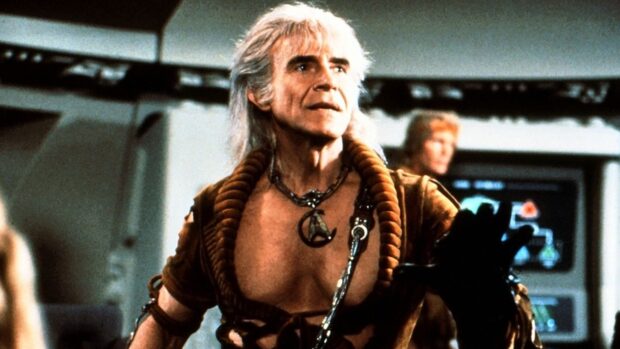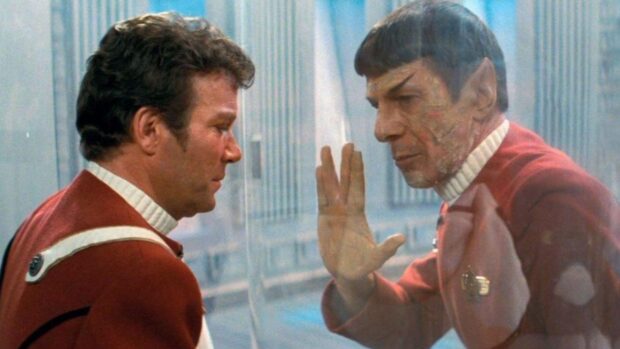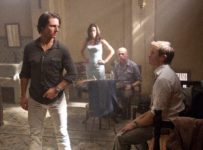“This is all Ahab,” director Nicholas Meyer once said in an interview. “I just cribbed it.”
He was talking about one of Ricardo Montalbán’s most iconic lines from STAR TREK II: THE WRATH OF KHAN: “I’ll chase him round the Moons of Nibia and round the Antares Maelstrom and round Perdition’s flames before I give him up!” Yet given that the line comes as his Khan and William Shatner’s Kirk engage in a battle of wills, one that can only end in mutual casualties, Meyer could have been talking about his whole picture.
Forty years since its release, KHAN remains one of the definite examples of big screen Star Trek. It’s an action-packed adventure filled with explosions and heart in equal measure, one that put memories of the more intellectual Star Trek: The Motion Picture to bed. It kicked off a sci-fi summer that included E.T. The Extra-Terrestrial, Blade Runner, The Thing and Tron. Yet in 1982, you couldn’t find something further from the franchise’s oeuvre.
Needs of the few
The storied and embattled history of Star Trek is well-covered territory. After suffering rejection for his original pilot in 1964, creator Gene Roddenberry got a rare second chance when a second pilot was ordered. With a new cast and a fun outlook, the familiar crew we grew to love over three years emerged in 1966. Despite threats of cancellation after the second season, a letter campaign saved the film for a troubled third year. Several attempts to craft a sequel series (or Phase II) failed to take off, but after the success of Star Wars (1977), Paramount greenlit Star Trek: The Motion Picture (1979).
With its contemplative attitude and measured pace, the visually stunning film failed to connect with critics but was successful enough to warrant a sequel. (In fact, despite common misconceptions, the film sold the most tickets of any film in the franchise in the US until Star Trek (2009), and it remains the highest-grossing film of the franchise worldwide adjusted for inflation). Nevertheless, Paramount studio heads — including Jeffrey Katzenberg and Michael Eisner – asked producer Harve Bennett if he could make a better film. It turns out he could.
The Motion Picture’s coda tells us ‘The Human adventure is just beginning.’ Which was true in a way, it just took three years for that adventure to be reworked with a greater emphasis on action and character-building. Flying in the face of youth-oriented sci-fi, it acknowledges the inevitability of ageing. From the moment ‘Bones’ McCoy (DeForest Kelley) gifts Kirk (William Shatner) a pair of reading glasses, Jack B. Sowards’ screenplay not only allows Kirk to pass gracefully into middle-age but foreshadows an even sharper reminder of mortality.
Kobayashi Maru
STAR TREK: THE WRATH OF KHAN begins with death. In fact, everyone dies in the opening scene. It turns out to be a training session led by Admiral James T. Kirk, the infamous Kobayashi Maru no-win scenario. The lesson for cadets is that sometimes defeat is inevitable, but it’s a lesson Kirk has never learned. He is famous for being the only person to have beaten the test — but only by hacking the system.
Meanwhile, the starship Reliant is looking for places to test Dr. Carol Marcus’ (Bibi Besch) Genesis device, a powerful scientific development that can terraform a planet in moments. When they land on what seems to be a deserted planet, the crew instead find genetically engineered tyrant Khan Noonien Singh (Ricardo Montalbán) and his crew, who the Enterprise had mistakenly left stranded there back in the classic episode Space Seed. Suffice it to say, he isn’t happy with Kirk.
Shifting the tone to a navy-inspired action adventure, from the military uniforms to the blinking lights of the ships, Meyer operates the Enterprise like a submarine in space. As a result, the relentless pace of the action combines the claustrophobia of the ships, arguably echoing Wolfgang Petersen’s Das Boot released a year earlier. The space battles are every bit as exciting as anything in Star Wars or Empire Strikes Back, and the stakes are heightened by the constant threats to characters we’ve known for the better part of two decades at this point.
Of course, one of the oft-cited fun facts of WRATH OF KHAN is that Kirk and Khan never share a set. They face off across view screens – and Khan’s name is yelled by Kirk in one of the film’s most famous and parodied moments – and yet they never once set foot on the same bridge. Yet their mutual appetite for the scenery ensures that their respective presence continues to compete for audience attention, much to the delight of viewers everywhere.
Yet it’s the death of a colleague that is arguably the most iconic moment in the film. Death, mortality and new life pervades every aspect of film, including the revelation that Carol’s son David (Merritt Butrick) is Kirk’s son. However, all of that pales in comparison to final moment of sacrifice, one in which Spock (Leonard Nimoy) famously gives his life to save the crew. The poignant moment maintains his credo that the ‘needs of the many outweigh the needs of the few’ (or the one), but leaves the crew and the viewer alike devastated. As a missile tube carrying Spock’s body is fired into space, a broken-voiced Kirk eulogises: “Of my friend, I can only say this: of all the souls I have encountered in my travels, his was the most… human.”
“I have been – and always shall be – your friend.”
Death would not be the final frontier for Spock. As Kirk adds in his eulogy, “in the midst of our sorrow, this death takes place in the shadow of new life.” This was the literal case in the narrative, given the appropriately-named Genesis planet was already starting to terraform before their eyes. Yet it was also true for the franchise, breathing new life into a series that would continue through an additional four films with this crew. THE WRATH OF KHAN opened on 4 June 1982 in 1,621 theatres in the US, and made over $14 million in its opening weekend, at the time the largest opening weekend gross in history. It ultimately became the first chapter in a story arc that ran through Star Trek III: The Search for Spock and Star Trek IV: The Voyage Home, crafting one of the great mid-series trilogies of all time.
You could also argue that this broke the mould for ‘Trek pictures, pushing them into naval action territory and away from the exploratory stuff that made the series a staple. Yet forty years later, the franchise has found infinite diversity in seemingly infinite combinations. Star Trek in 2022 is many things. It’s a far-future oratory in Discovery. It’s nostalgia viewed through a glass darkly in Picard. It’s self-aware and wry in Lower Decks, broad and kid-friendly in Prodigy and unabashedly retro in Strange New Worlds. Had THE WRATH OF KHAN failed, Trek may never again dared to experiment with the form so boldly.
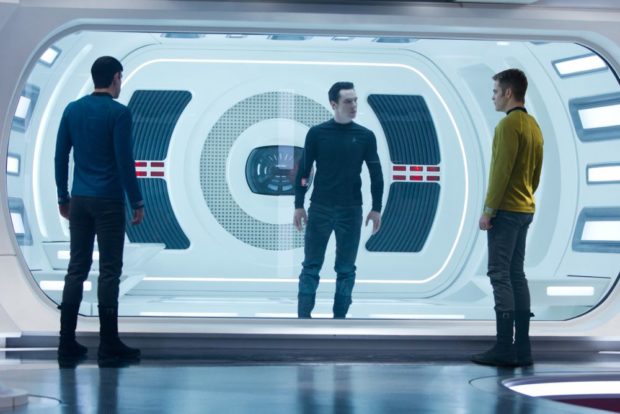
In 2013, the rebooted Star Trek Into Darkness attempted a soft remake of this classic sequel. In that version, Benedict Cumberbatch’s Khan faces off against Chris Pine’s Kirk in a battle of wills that mirrors the 21st century’s war on terror. If it speaks in shorthand, right down to a cheeky double-bluff ending, it’s because WRATH OF KHAN did the heavy lifting in 1982. It has been, and always shall be, the absolute best of theatrical Star Trek.

